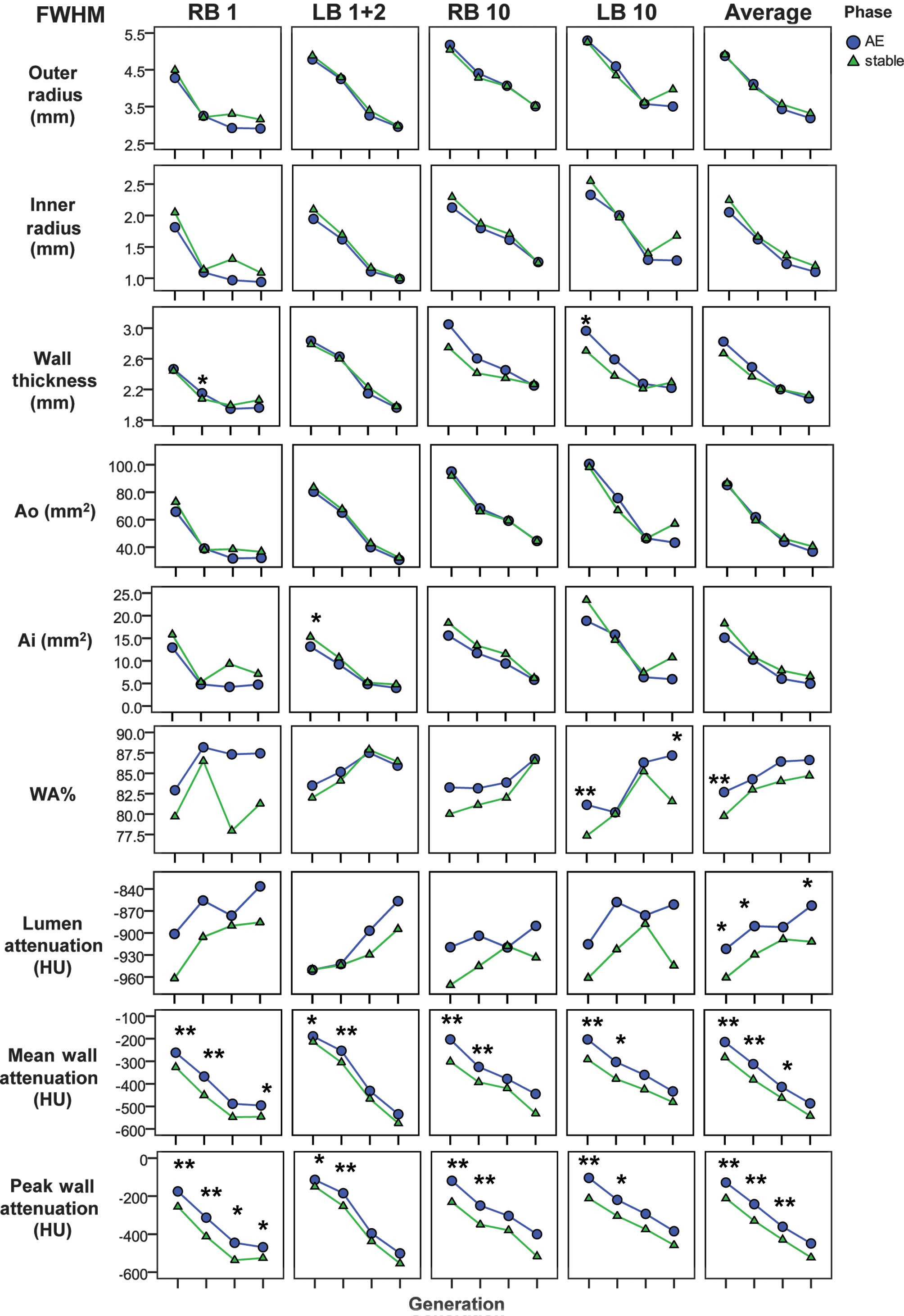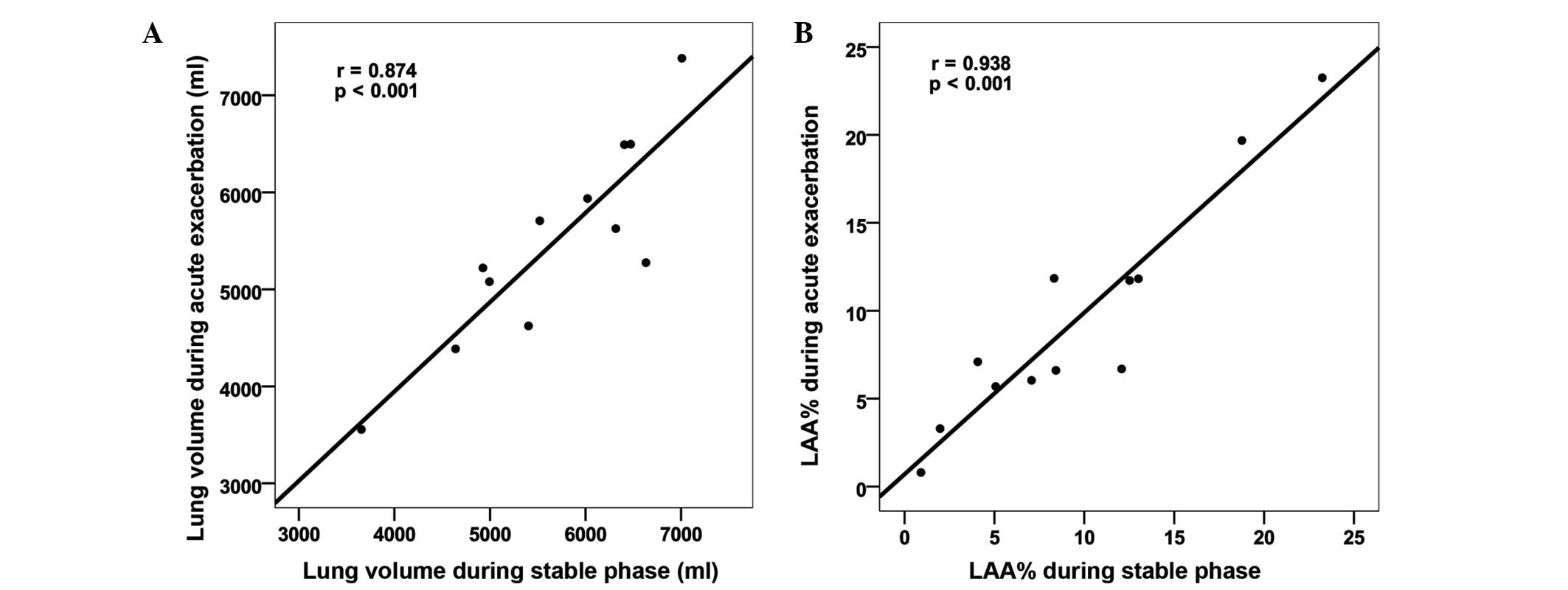|
1
|
Lopez AD, Shibuya K, Rao C, Mathers CD,
Hansell AL, Held LS, Schmid V and Buist S: Chronic obstructive
pulmonary disease, Current burden and future projections. Eur
Respir J. 27:397–412. 2006. View Article : Google Scholar : PubMed/NCBI
|
|
2
|
Global Strategy for the Diagnosis,
Management and Prevention of Chronic Obstructive Pulmonary Disease,
Global Initiative for Chronic Obstructive Lung Disease (GOLD).
2011.Available from: http://www.goldcopd.org/ and. http://www.goldcopd.org/uploads/users/files/GOLD_Report_2011_Feb21.pdf
|
|
3
|
Hogg JC and Timens W: The pathology of
chronic obstructive pulmonary disease. Annu Rev Pathol. 4:435–459.
2009. View Article : Google Scholar : PubMed/NCBI
|
|
4
|
Szilasi M, Dolinay T, Nemes Z and Strausz
J: Pathology of chronic obstructive pulmonary disease. Pathol Oncol
Res. 12:52–60. 2006. View Article : Google Scholar : PubMed/NCBI
|
|
5
|
Hogg JC: Pathophysiology of airflow
limitation in chronic obstructive pulmonary disease. Lancet.
364:709–721. 2004. View Article : Google Scholar : PubMed/NCBI
|
|
6
|
Snider GL: Chronic obstructive pulmonary
disease - a continuing challenge. Am Rev Respir Dis. 133:942–944.
1986.PubMed/NCBI
|
|
7
|
Dunnill MS, Massarella GR and Anderson JA:
A comparison of the quantitative anatomy of the bronchi in normal
subjects, in status asthmaticus, in chronic bronchitis, and in
emphysema. Thorax. 24:176–179. 1969. View Article : Google Scholar : PubMed/NCBI
|
|
8
|
Litmanovich D, Boiselle PM and Bankier AA:
CT of pulmonary emphysema - current status, challenges, and future
directions. Eur Radiol. 19:537–551. 2009. View Article : Google Scholar : PubMed/NCBI
|
|
9
|
Nakano Y, Wong JC, de Jong PA, Buzatu L,
Nagao T, Coxson HO, Elliott WM, Hogg JC and Paré PD: The prediction
of small airway dimensions using computed tomography. Am J Respir
Crit Care Med. 171:142–146. 2005. View Article : Google Scholar : PubMed/NCBI
|
|
10
|
Nakano Y, Muro S, Sakai H, Hirai T, Chin
K, Tsukino M, Nishimura K, Itoh H, Paré PD, Hogg JC and Mishima M:
Computed tomographic measurements of airway dimensions and
emphysema in smokers. Histopathology. Am J Respir Crit Care Med.
162:1102–1108. 2000. View Article : Google Scholar : PubMed/NCBI
|
|
11
|
Perera PN, Armstrong EP, Sherrill DL and
Skrepnek GH: Acute exacerbations of COPD in the United States,
Inpatient burden and predictors of costs and mortality. COPD.
9:131–141. 2012. View Article : Google Scholar : PubMed/NCBI
|
|
12
|
Burge S and Wedzicha JA: COPD
exacerbations: Definitions and classifications. Eur Respir J
(Suppl). 41:S46–S53. 2003.
|
|
13
|
Miller MR, Hankinson J, Brusasco V, Burgos
F, Casaburi R, Coates A, Crapo R, Enright P, van der Grinten CP,
Gustafsson P, et al: ATS/ERS Task Fore: Standardisation of
spirometry. Eur Respir J. 26:319–38. 2005. View Article : Google Scholar : PubMed/NCBI
|
|
14
|
Han MK, Kazerooni EA, Lynch DA, Liu LX,
Murray S, Curtis JL, Criner GJ, Kim V, Bowler RP, Hanania NA, et
al: COPD Gene Investigators: Chronic obstructive pulmonary disease
exacerbations in the COPD Gene study: Associated radiologic
phenotypes. Radiology. 261:274–282. 2011. View Article : Google Scholar : PubMed/NCBI
|
|
15
|
Estepar RSJ, Washko GG, Silverman EK,
Reilly JJ, Kikinis R and Westin CF: Airway inspector: An open
source application for lung morphometry in First International
Workshop on Pulmonary Image Processing. New York City, USA:
293–302. 2008.
|
|
16
|
Yamashiro T, Matsuoka S, Estépar RS,
Dransfield MT, Diaz A, Reilly JJ, Patz S, Murayama S, Silverman EK,
Hatabu H and Washko GR: Quantitative assessment of bronchial wall
attenuation with thin-section CT, An indicator of airflow
limitation in chronic obstructive pulmonary disease. AJR Am J
Roentgenol. 195:363–369. 2010. View Article : Google Scholar : PubMed/NCBI
|
|
17
|
Martinez CH, Chen YH, Westgate PM, Liu LX,
Murray S, Curtis JL, Make BJ, Kazerooni EA, Lynch DA, Marchetti N,
et al: COPD Gene Investigators: Relationship between quantitative
CT metrics and health status and BODE in chronic obstructive
pulmonary disease. Thorax. 67:399–406. 2012. View Article : Google Scholar : PubMed/NCBI
|
|
18
|
Tanaka N, Matsumoto T, Kuramitsu T, Nakaki
H, Ito K, Uchisako H, Miura G, Matsunaga N and Yamakawa K: High
resolution CT findings in community-acquired pneumonia. J Comput
Assist Tomogr. 20:600–608. 1996. View Article : Google Scholar : PubMed/NCBI
|
|
19
|
Kothari RU, Brott T, Broderick JP, Barsan
WG, Sauerbeck LR, Zuccarello M and Khoury J: The ABCs of measuring
intracerebral hemorrhage volumes. Stroke. 27:1304–1305. 1996.
View Article : Google Scholar : PubMed/NCBI
|
|
20
|
Washko GR, Dransfield MT, Estépar RS, Diaz
A, Matsuoka S, Yamashiro T, Hatabu H, Silverman EK, Bailey WC and
Reilly JJ: Airway wall attenuation, A biomarker of airway disease
in subjects with COPD. J Appl Physiol (1985). 107:185–191. 2009.
View Article : Google Scholar : PubMed/NCBI
|
|
21
|
Lederlin M, Laurent F, Dromer C, Cochet H,
Berger P and Montaudon M: Mean bronchial wall attenuation value in
chronic obstructive pulmonary disease, Comparison with standard
bronchial parameters and correlation with function. AJR Am J
Roentgenol. 198:800–808. 2012. View Article : Google Scholar : PubMed/NCBI
|
|
22
|
Hasegawa M, Nasuhara Y, Onodera Y, Makita
H, Nagai K, Fuke S, Ito Y, Betsuyaku T and Nishimura M: Airflow
limitation and airway dimensions in chronic obstructive pulmonary
disease. Am J Respir Crit Care Med. 173:1309–1315. 2006. View Article : Google Scholar : PubMed/NCBI
|
|
23
|
Tanabe N, Muro S, Hirai T, Oguma T, Terada
K, Marumo S, Kinose D, Ogawa E, Hoshino Y and Mishima M: Impact of
exacerbations on emphysema progression in chronic obstructive
pulmonary disease. Am J Respir Crit Care Med. 183:1653–1659. 2011.
View Article : Google Scholar : PubMed/NCBI
|
|
24
|
de Jong YP, Uil SM, Grotjohan HP, Postma
DS, Kerstjens HA and van den Berg JW: Oral or IV prednisolone in
the treatment of COPD. exacerbations. A randomized, controlled,
double-blind study. Chest. 132:1741–1747. 2007. View Article : Google Scholar : PubMed/NCBI
|
|
25
|
Aaron SD, Vandemheen KL, Hebert P, Dales
R, Stiell IG, Ahuja J, Dickinson G, Brison R, Rowe BH, Dreyer J, et
al: Outpatient oral prednisone after emergency treatment of chronic
obstructive pulmonary disease. N Engl J Med. 348:26182003.
View Article : Google Scholar : PubMed/NCBI
|
|
26
|
Maltais F, Ostinelli J, Bourbeau J, Tonnel
AB, Jacquemet N, Haddon J, Rouleau M, Boukhana M, Martinot JB and
Duroux P: Comparison of nebulized budesonide and oral prednisolone
with placebo in the treatment of acute exacerbations of chronic
obstructive pulmonary disease, A randomized controlled trial. Am J
Respir Crit Care Med. 165:6982002. View Article : Google Scholar : PubMed/NCBI
|
|
27
|
Lieberman D, Lieberman D, Gelfer Y,
Varshavsky R, Dvoskin B, Leinonen M and Friedman MG: Pneumonic vs
nonpneumonic acute exacerbations of COPD. Chest. 122:1264–1270.
2002. View Article : Google Scholar : PubMed/NCBI
|
|
28
|
Myint PK, Lowe D, Stone RA, Buckingham RJ
and Roberts CM: U.K. Histopathology. Respiration. 82:320–327. 2011.
View Article : Google Scholar : PubMed/NCBI
|
|
29
|
Hayden GE and Wrenn KW: Chest radiograph
vs. Histopathology. J Emerg Med. 36:266–270. 2009. View Article : Google Scholar : PubMed/NCBI
|
|
30
|
Mandell LA, Wunderink RG, Anzueto A,
Bartlett JG, Campbell GD, Dean NC, Dowell SF, File TM Jr, Musher
DM, Niederman MS, et al: Infectious Diseases Society of America;
American Thoracic Society: Infectious Diseases Society of
America/American Thoracic Society consensus guidelines on the
management of community-acquired pneumonia in adults. Clin Infect
Dis. 44((Suppl 2)): S27–S72. 2007. View
Article : Google Scholar : PubMed/NCBI
|
|
31
|
Steer J, Norman EM, Afolabi OA, Gibson GJ
and Bourke SC: Dyspnoea severity and pneumonia as predictors of
in-hospital mortality and early readmission in acute exacerbations
of COPD. Thorax. 67:117–121. 2012. View Article : Google Scholar : PubMed/NCBI
|
|
32
|
Syrjälä H, Broas M, Suramo I, Ojala A and
Lähde S: High-resolution computed tomography for the diagnosis of
community-acquired pneumonia. Clin Infect Dis. 27:358–363. 1998.
View Article : Google Scholar : PubMed/NCBI
|













